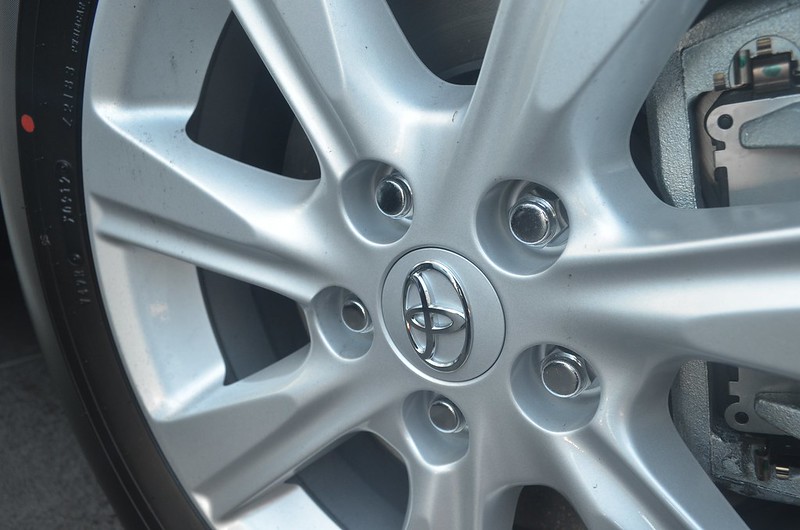
Tire maintenance is a vital part of car ownership because your tires are the only contact that your vehicle has with the road. Did you know that driving around in your Toyota with low tire pressure could potentially put your safety in jeopardy? You’ll be at an increased risk of experiencing a tire blowout, and if it just so happens to occur while you’re driving down the highway, you could lose control of your car and get into an accident.
Fortunately, you should be able to avoid this scenario thanks to your Toyota’s Tire Pressure Monitoring System (TPMS). This system is specifically designed to let you know when you don’t have enough air in your tires so that you can fill them up as soon as possible. It’s important to know how this system works so that have a better understanding of how it’ll help you when you’re behind the wheel of your Toyota.
The team at Longo Toyota of El Monte, California, has put together this guide to help you understand the features of your Toyota’s TPMS. Read on to find out how the Toyota TPMS is designed to keep you safe
Monitors the Tire Pressure in Each of Your Toyota’s Tires

From pretty much the moment that you start up your Toyota, your vehicle’s TPMS is up and running. It monitors all four of the tires on your Toyota and checks to see how much air is in each of them. The system has a series of sensors that keeps tabs on things such as the temperature of the air in your tires to determine whether or not they need to be filled with more air.
Without the TPMS, you wouldn’t know if your tires were ever running low on air. This could result in you driving around in a car, truck, or SUV that isn’t getting the kind of gas mileage that it should. It could also result in you damaging your car’s tires and possibly even getting into an accident because of them.
Alerts You If Your Toyota’s Tires Are Low on Air
Most of the time, your Toyota’s Tire Pressure Monitoring System is going to be running in the background and won’t have to alert you about anything. But if your Toyota’s tires are running low on air, the system will advise you as to what’s going on.
How will it do this? Well, there’s a TPMS warning light, which is also commonly referred to as a TPMS warning light. It’ll light up on your dashboard if your TPMS ever senses that you need air in one or more of your vehicle’s tires.
You might not necessarily need to pull over at the exact moment that you see your TPMS warning light turn on. But you should make checking your tire pressure and adding air to your tires a top priority. You don’t want to get stuck riding around in a Toyota that has low tire pressure for too long as it can put you and your passengers at risk.
Allows You To Add Air to Your Toyota’s Tires
Once you see your TPMS warning light turn on, it’ll stay on until you do something about it. That should serve as a constant reminder that you need to add air to your tires. There’s always a chance that the temperature outside could increase and cause your tire pressure to rise on its own, but when your car gets to the point that the TPMS warning light turns on, it’s often a clear indication that one of your tires is dangerously low on air.
What To Do If Your Toyota’s TPMS Warning Light Doesn’t Turn Off
After you add air to your Toyota’s tires, the light should turn back off for you. At least, that’s what it’s supposed to do. There are, however, some instances in which your Toyota’s TPMS warning light might turn on and then not turn back off. This sometimes happens to Toyota owners after they have a tire rotation done or replace the tires on their cars. If this ever happens to you, you’ll need to manually reset the TPMS warning light yourself. You can do this by:
- Starting your Toyota and letting the engine run
- Pressing and holding down the Reset button that’s usually positioned on the instrumental panel that’s on the right of the steering wheel in most Toyotas
- Releasing the Reset button after the TPMS warning light blinks three times
- Allowing your Toyota to run for a few more minutes before turning it off and completing the Reset process
- Starting your Toyota again and checking to see if all this led to the TPMS warning light turning off
As long as you take each of these steps, you should be able to turn your TPMS warning light off and keep it off. But if you see that the light is still on, it could be a sign of more serious trouble. In this case, you’ll need to arrange to take your Toyota down to a local service center so that they can try and establish the cause of the problem. A factory-trained technician will be able to figure it out in no time for you.
Reach Out to Us To Schedule Service for Your Toyota
Are you experiencing trouble with your Toyota? Whether the TPMS warning light won’t go off or you suspect there might be something else going on, Longo Toyota or El Monte, California, can help you out. We can inspect your TPMS and other aspects of your car to find out what the problem is.
If you’d like to make an appointment for your Toyota at our service center, contact us today so that we can get you on the schedule and get an explanation as to why your TPMS isn’t working. We also have a wide variety of new and used models for when you’re ready to move on to your next vehicle.





